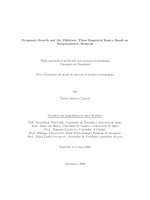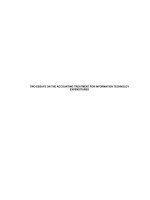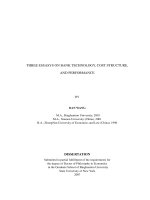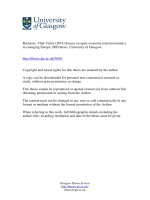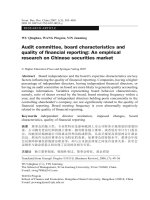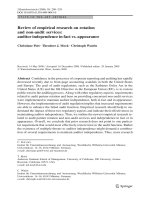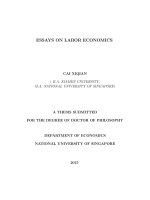Three Empirical Essays on Bank Accounting
Bạn đang xem bản rút gọn của tài liệu. Xem và tải ngay bản đầy đủ của tài liệu tại đây (1.49 MB, 214 trang )
Three Empirical Essays on Bank Accounting
A Thesis submitted to the University of Manchester for the degree of
Doctor of Philosophy
In the Faculty of Humanities
2012
CHU YEONG LIM
MANCHESTER BUSINESS SCHOOL
List of contents
ABSTRACT ..................................................................................................................... 5
DECLARATION ............................................................................................................ 6
COPYRIGHT STATEMENT ........................................................................................ 7
ACKNOWLEDGEMENTS ............................................................................................ 8
1. INTRODUCTION ..................................................................................................... 12
2. BANK ACCOUNTING CONSERVATISM AND BANK LENDING BEHAVIOUR
........................................................................................................................................ 23
2.1. Introduction ............................................................................................................ 24
2.2. Literature Review and Institutional Setting .......................................................... 27
2.2.1. Literature Review .................................................................................................. 27
2.2.1.1. Accounting conservatism..................................................................................... 27
2.2.1.2. Loan loss accounting ........................................................................................... 31
2.2.1.3. Credit crisis ......................................................................................................... 32
2.2.2. Institutional Setting ............................................................................................... 33
2.2.2.1. Loan syndication market ..................................................................................... 33
2.2.2.2. Loan provisioning process .................................................................................. 34
2.3. Hypotheses Development ....................................................................................... 35
2.4. Methodology and Data ........................................................................................... 38
2.4.1. Methodology .......................................................................................................... 38
2.4.2. Data ....................................................................................................................... 44
2.5. Empirical Results .................................................................................................... 46
2.5.1. Descriptive Statistics ............................................................................................. 46
2.5.2. Main Results ......................................................................................................... 51
2
2.6. Conclusion .............................................................................................................. 57
3. BANK RISK AND THE VALUE RELEVANCE OF FAIR VALUE GAINS AND
LOSSES ......................................................................................................................... 73
3.1. Introduction ............................................................................................................ 75
3.2. Institutional Setting and Prior Literature ............................................................. 76
3.2.1. The economic nature of banks ............................................................................... 76
3.2.2. The demand for fair value information ................................................................... 77
3.2.3. The problems with fair value accounting ............................................................... 79
3.2.4. Accounting standards involving fair value accounting ........................................... 82
3.2.5. Bank regulatory and corporate governance environment ........................................ 84
3.2.6. Prior empirical literature ........................................................................................ 86
3.3. Hypotheses Development ....................................................................................... 90
3.4. Research Design ..................................................................................................... 95
3.4.1. Methodology ......................................................................................................... 95
3.4.2. Sample Selection ................................................................................................... 99
3.5. Empirical Results ................................................................................................. 102
3.5.1. Descriptive statistics and correlations .................................................................. 102
3.5.2. Main results ......................................................................................................... 104
3.5.3. Additional Tests .................................................................................................. 109
3.5.3.1. Additional controls for size and bank credit default swap rates ......................... 109
3.5.3.2. Alternative Risk Proxies ................................................................................... 109
3.5.3.3. Additional tests on the alternative possibility .................................................... 112
3.5.3.4. Further Remarks on the Crisis Period ............................................................... 113
3.6. Conclusion ............................................................................................................ 115
4. ARE THE LOAN LOSS AND FAIR VALUE COMPONENTS OF BANK
INCOME RATIONALLY PRICED?.............................................................................134
3
4.1. Introduction .......................................................................................................... 135
4.2. Literature Review ................................................................................................. 137
4.2.1. Accrual anomaly ................................................................................................. 138
4.2.2. Bank loan provisions ........................................................................................... 143
4.2.3. Fair value accounting .......................................................................................... 146
4.3. Hypotheses Development ..................................................................................... 148
4.4. Research Design ................................................................................................... 159
4.4.1. Methodology ....................................................................................................... 159
4.4.2. Sample selection ................................................................................................. 165
4.5. Empirical Results ................................................................................................. 166
4.5.1. Descriptive statistics and correlations .................................................................. 166
4.5.2. Main results ......................................................................................................... 170
4.6. Conclusion ............................................................................................................ 183
5. SUMMARY AND SUGGESTIONS FOR FUTURE RESEARCH ....................... 206
Total Word Count: 53,244
4
Abstract
The University of Manchester
Chu Yeong Lim
Doctor of Philosophy (PhD)
Three Empirical Essays on Bank Accounting
November 2012
This thesis presents new empirical evidence on three important aspects of financial
reporting by banks. The thesis consists of an introductory chapter that explains how the
three issues are related to each other, three empirical chapters and a final summary chapter.
The first empirical chapter studies the effects of accounting conservatism on the pricing of
syndicated bank loans. I provide evidence that banks more timely in loss recognition
charge higher spreads for the same loan provision. I go on to consider what happens to this
relationship during the financial crisis. During the crisis, banks more timely in loss
recognition increase their spreads to a lesser extent than banks less timely in loss
recognition. The policy implication is that banks more timely in loss recognition exhibit
more prudent and less pro-cyclical debt pricing behaviour.
The second empirical chapter examines the relationship between the value relevance of fair
value gains and losses and bank risk in an international bank sample. One possibility is that,
as risk increases, the scope for subjectivity in fair value estimates increases thereby
potentially rendering the numbers less useful. However another possibility is that the
relevance of faithfully reported fair value gains and losses increases as risk increases. The
study provides evidence that the value relevance of fair value gains and losses is positively
associated with bank risk prior to the crisis. During the crisis there is also evidence of a
similar positive relationship, but it is not possible to draw firm conclusions for reasons
discussed in the chapter. My research also shows that the fair value gains and losses of
banks that elect to use the fair value option for assets that could have been accounted for
using amortized costs are more value relevant and persistent. This study provides
information to policy makers on the situations when fair values are most useful to investors.
The third empirical chapter examines if the market rationally prices the loan loss
provisions, and the reported fair value gains and losses of US banks. The chapter models
the discretionary components of loan loss provisions and fair value gains and losses, and
tests if the discretionary components are priced differently from their non-discretionary
counterparts. The results provide little evidence that the market misprices operating cash
flows, non-discretionary loan loss provisions, or fair value gains and losses (discretionary
or otherwise). However there is evidence of significant mispricing of discretionary loan
loss provisions. The lack of evidence on the mispricing of fair value gains and losses is
consistent with the finding on the value relevance of fair value gains and losses in the
second empirical chapter.
5
Declaration
No portion of the work referred to in the thesis has been submitted in support of an
application for another degree or qualification of this or any other university or other
institute of learning.
6
Copyright Statement
(i)
Copyright in text of this thesis rests with the Author. Copies (by any
process) either in full, or of extracts, may be made only in accordance with
instructions given by the Author and lodged in the John Rylands
University Library of Manchester. Details may be obtained from the
Librarian. This page must form part of any such copies made. Further
copies (by any process) of copies made in accordance with such
instructions may not be made without the permission (in writing) of the
Author.
(ii)
The ownership of any intellectual property rights which may be described
in this thesis is vested in The University of Manchester, subject to any
prior agreement to the contrary, and may not be made available for use by
third parties without the written permission of the University, which will
prescribe the terms and conditions of any such agreement.
(iii)
Further information on the conditions under which disclosures and
exploitation may take place is available from the Head of Manchester
Business School.
7
Acknowledgements
First, I would like to express my heartfelt gratitude to my supervisors Martin Walker,
Edward Lee and Asad Kausar for accepting me to be their student. I would like to thank
them for their patient guidance and support during the Phd process. Their kind guidance
and support have been highly persistent throughout the process. I have benefited greatly
from their wealth of knowledge and expertise in academic research, which they have
kindly shared with me. The thesis would not have been possible without their sound advice
and feedback. They have also guided me in the presentations at the various conferences
and seminars. I also thank them for their kind understanding of my personal situation.
Besides my supervisors, this thesis has benefited from the feedback and comments of many
people when I presented each chapter paper at various conferences and seminars. I would
like to thank Robert Hodgkinson, Ken Peasnell, Stephen Zeff, Geoff Whittington, Chris
Nobes, Stuart McLeay, Geoff Meeks, Alfred Wagonhofer, Andrew Stark, Norman Strong,
Richard Taffler, Ser Huang Poon, David Brierwood, Kevin Ow Yong, Atif Ellahie, the
2010 Manchester Business School doctoral conference participants, attendees at the
December 2011 UK ASB academic panel meeting, participants at the 2011 Marie Curie
mid-term conference in Berlin, the 2011 Marie Curie workshop participants, the 2012
London Business School Trans-Atlantic doctoral conference participants, attendees at the
Manchester Business School Phd reviews, Pauline Weetman and an anonymous reviewer
of the Accounting and Business Research for their helpful comments. I also thank Stuart
Turley and John O‟Hanlon for taking the time to be my examiners and for giving helpful
comments to improve the thesis.
8
I also wish to thank Martin Walker, Christopher Humphrey and Stuart Turley, for granting
me the Marie Curie research fellowship. Christopher Humphrey has also kindly given me
useful comments for this thesis. At this stage, I would like to acknowledge the Marie Curie
research funding from the European Community's Seventh Framework Programme FP7PEOPLE-ITN-2008 under grant agreement number PITN-GA-2009-237984 for my thesis.
Next, I would like to thank Claire Faichnie and Anusarin Lowe of the Manchester Business
School Postgraduate Research Office for always being very helpful by going the extra mile
to help me on administrative matters in relation to research.
I also wish to acknowledge the funding from the Singapore Management University (SMU)
for my Phd research. I thank Pang Yang Hoong, the Dean of the SMU School of
Accountancy for her encouragement and support during my Phd. I am also thankful for the
constant kind words of encouragement from many friends and colleagues of the SMU
School of Accountancy. Among them, I specially thank Pearl Tan and Andrew Lee, who
believed in me and wrote the reference letters for me in my applications to the Phd
programmes.
There are many friends who accompanied me during this Phd journey and I appreciate
their friendships. They include my Phd classmates Colin Cheng Zeng, Jirada Petaibanlue,
Chanchai Tangruenrat, Chiwamit Pimsiri and Agyenim Cletus. In particular, I would like
to thank my flat-mate Colin and his wife Qianghui for their warmth and friendship.
Outside the academia, I thank many friends (too numerous to name) for giving me the
morale support. Augustine Law is one close friend whom I could always turn to in difficult
times and I have special thanks for him.
9
Now, I come to the most special group of people in my life. My family is a pillar of
support for me during this Phd process. I wish to thank my wife for taking care of our
daughter while I am away. I would like to thank her for patiently waiting for my return.
My daughter has provided me with the comfort and joy whenever I am home during breaks,
for which I am thankful. My father and mother have always played the most special and
important roles in my life journey. They are always there for me, encouraging me and
constantly giving me the full support. I am eternally indebted to them. I also thank my
brothers for their brotherly love and their morale support. Finally, I thank God for making
the completion of my Phd thesis possible.
10
To my parents, I dedicate this thesis
11
Chapter 1
Introduction
Bank accounting, in particular loan loss accounting and fair value accounting, was a
controversial area before the financial crisis and became even more controversial after the
financial crisis. The importance of loan loss accounting and fair value accounting is
underscored by data that shows the economic significance of loans and fair valued
financial instruments. Loans and investments make up 64% and 25% of all banks‟ total
assets respectively in 2009 (Bank for International Settlements, 2012). The bank
accounting issues are discussed below in the order they are covered in the thesis.
Chapter 2 issues
Accounting conservatism has a rich academic literature but most of the prior studies focus
on borrowers and industrial firms (Beatty et al., 2008; Zhang, 2008). There have been few
studies on bank accounting conservatism although accounting conservatism in the context
of bank loan provisions is important due to the substantial discretion and judgement
required in setting loan provisions (Ahmed et al., 1999; Kanagaretnam et al., 2004; Lobo,
2011). Examples of studies on bank accounting conservatism are Beatty and Liao (2011),
O‟Hanlon (2011), Bhat et al. (2012) and Bushman and Williams (2012).
Beatty and Liao hypothesise that during an expansionary period, increases in pre-provision
equity are greater for banks with smaller delays in expected loss recognition than for those
with greater delays. This is primarily because the former have less capital adequacy
concerns and take action to build up capital. As a result, banks which recognize loan
provisions on a more (less) timely basis face less (greater) credit crunch during the crisis
12
and reduce their lending volume to a lesser (greater) extent. Beatty and Liao report
evidence to support the above hypotheses.
O'Hanlon (2011) provides evidence that suggests loan provisioning becomes timelier for
UK banks after IAS 39 was introduced, particularly for UK public banks.
While Beatty and Liao point to regulatory capital as a reason for bank accounting
conservatism, Bhat et al. (2012) suggest that credit risk modelling is another reason for the
timeliness in recognizing loan losses. Their study shows that financial report disclosures of
credit risk modelling techniques can influence the timeliness of loan loss recognition.
Bushman and Williams (2012) investigate the economic consequences of two measures of
forward looking discretionary loan provisions. One measure is smoothing, derived from
the coefficient in the regression of loan provisions on contemporaneous earnings. Another
measure is the timeliness in expected loan loss recognition, defined as the coefficient in the
regression of loan provisions on next year non-performing loans. The smoothing
(timeliness in loan loss recognition) measures are associated with reduced (increased)
discipline in bank risk-taking.
In contrast to these studies, my first chapter provides new empirical evidence that banks
more timely in loss recognition charge higher spreads than those less timely in loss
recognition. In addition, my study shows that during the crisis the increase in spreads is
lower for the banks more timely in loss recognition than those less timely in loss
recognition.
13
Chapter 2 is motivated by the accounting conservatism and bank accounting literature. I
study bank accounting conservatism in the context of the market for syndicated loans
because they constitute a significant component of the loan market, representing about 7%
of a typical bank‟s balance sheet on December 2011 (BIS Quarterly Review, 2012) and
syndicated loans provide higher underwriting revenues than either the equity or the bond
market (Ball et al., 2008). Despite the rich literature on borrower accounting conservatism
(Watts, 2003; La Fond and Watts, 2007), there have been few studies on bank accounting
conservatism. While borrower conservatism is driven by lender demand (Beatty et al.,
2008) and conservative borrowers benefit by obtaining lower interest costs (Zhang, 2008),
I expect and find that conservative banks make sound and prudent economic decisions by
charging higher spreads than less conservative banks. I also test the effects of an
exogenous event in the form of credit crisis on the relation between bank accounting
conservatism and bank lending behaviour. In prior literature, Beatty and Liao (2011)
provide evidence that banks which recognize loan losses on a less timely basis face a
greater credit crunch during the financial crisis and reduce their lending volume to a larger
extent than banks which are timely in recognizing loan losses. Based on the same theory, I
hypothesise and report evidence that the less conservative banks increase their spreads to a
greater extent than the conservative banks when the economic environment deteriorates.
This chapter contributes to the accounting conservatism and bank accounting literature by
documenting the relationship between bank accounting conservatism and bank lending
behaviour in the general case and when the economic situation worsens. In short, the more
accounting conservative banks exhibit more prudent and less pro-cyclical lending
behaviour. This research has policy implications by highlighting that the accounting
practice (in terms of accounting conservatism) may matter more than the accounting
14
standard in relation to banks‟ lending behaviour. This is because the banks in this sample
use the incurred loan loss accounting standard, but they exhibit different levels of
accounting conservatism and lending behaviour. In view of the debates among accounting
standard setters on the loan loss accounting policy, this research provides inputs to the
policy makers to consider the incentives in the form of accounting conservatism that affect
loan provisions. The interaction between bank accounting conservatism and loan loss
provision is the key variable I investigate in this chapter, as loan loss provisions are used to
control for the varying borrower credit risks.
Chapter 3 issues
Laux and Leuz (2009) sum up the debate over fair value accounting, which centres on the
arguments over relevance versus reliability. Landsman (2006) gives a survey of the fair
value accounting issues around value-relevance and how they impact regulation through
their implementation. Fair value accounting proponents argue that fair values are relevant
to the markets and lead to greater transparency (Barth 1994; Barth et al., 1996). They also
argue that short term market prices are relevant to regulators to assess the banks‟ capital
requirements. Firms may not have the ability to hold the assets for the long term despite
their expressed intention to do so, in which case the short term market prices become
relevant to assess the assets‟ liquidation values. Fair value accounting provides early
warning signals for an impending crisis. To counter the argument that fair values can be
manipulated, a bank can still time the booking of gains under historical cost accounting by
selling its loans with gains and by selling loans via securitization.
On the other hand, the opponents of fair values are of the view that if firms hold assets to
maturity, the short term fair values distort the balance sheet when the markets are
15
inefficient, inactive, distressed or illiquid (Laux and Leuz, 2009). The fair value accounting
standards such as the IAS 39 and FAS 157 recognize the fact that markets may be illiquid
and permit the use of modelled values in place of market prices in such situations. This
leads to concerns over the subjective use of modelled prices and gaming by the firm
managers (Landsman, 2006; Penman, 2011). Penman argues that a transaction-driven
historical cost accounting methodology is more reliable than fair values based on market
prices which may be speculative. In addition, Riedl and Serafeim (2011) find that the
opacity of level 3 assets causes information asymmetry, increases trading bid-ask spreads
and increases costs of capital.
Chapter 3 contributes to the debates on fair value accounting by providing new empirical
evidence that the value relevance of fair values is positively related to bank risk. There is a
tension between opposing schools of thought. On the one hand, it is argued that as risk
increases, fair values become more subjective and thus less value-relevant (Benston, 2008;
Penman, 2011). On the other hand, fair values may become more value-relevant as risks
increase if they are faithfully reported (Barth, 1994; Barth et al., 1996). Using handcollected data that disaggregate the earnings and loan loss provisions by retail and
corporate lines of businesses, I find evidence that fair value value-relevance is positively
related to bank risks to support the latter argument. I also report that when banks elect to
use fair value option, their fair value gains and losses are more value relevant and
persistent.
My research contributes towards the debates on the relevance and reliability of fair values
in both the academic and the accounting policy making arena. The above evidence should
16
be of interest to policy makers because it reveals the situations when fair values are useful
to the equity markets.
Chapter 4 issues
There has been considerable debate among accounting standard setters on methods of loan
loss accounting. The debate remains unresolved at the present time.
IAS 39 and US GAAP currently use an incurred loan loss accounting approach in which
loan losses are recognized when there is objective evidence of the loss event such as the
bankruptcy of a borrower (IASB, 2009). However, the incurred loan loss accounting
standards have been severely criticised for delaying recognition of loan losses and for
being pro-cyclical (Turner, 2010).
Accounting standard setters have been working jointly to replace the existing accounting
standard with one that takes into account expected loan provisions. However, there have
been controversies and disagreements among regulators, standard setters and banks on the
conceptual approach to determine expected loan provisions and the debates are still ongoing. Consistent with the use of discretionary loan provisions for earnings and capital
management, as well as the fact that loan loss accounting is a difficult to understand topic,
this chapter gives new empirical evidence that loan provisions, in particular discretionary
loan provisions are mispriced by the stock market.
In contrast to the policy literature on loan loss accounting, the academic literature mostly
focuses on the use of loan provisions for signalling, earnings and capital management.
Wahlen (1994) find that the stock market interprets higher discretionary loan loss
17
provisions as managers signalling private „good news‟ information in the form of higher
future cash flows and leads to higher stock market prices. Liu et al. (1997) extend
Wahlen‟s study and explain that the positive relationship between loan provisions and
stock returns exists for banks which have low regulatory capital and in the fourth fiscal
quarter. Perez et al. (2008) find that Spanish banks manage earnings, though not capital
through the use of loan provisions. Kanagaretnam et al. (2004) consider situations with
different incentives for banks to signal or to smooth income to jointly test for signalling
and income smoothing using loan loss provisions. Incentives to signal are hypothesized to
be higher for undervalued banks while incentives to smooth income are hypothesized to be
higher when earnings before management show a greater difference to the norm. They find
results consistent with these hypotheses.
In chapter 4, I investigate if the equity market rationally prices loan provisions and fair
value gains and losses. Consistent with the value-relevance of fair value gains and losses in
chapter 3, I find little evidence that the equity market misprices fair value gains and losses
using the market mispricing tests in Sloan (1996). In contrast, I report evidence that loan
provisions are mispriced. Loan provisions are disaggregated between discretionary and
non-discretionary components using the discretionary loan provision models in prior
literature (Wahlen, 1994; Kanagaretnam et al., 2004). My research shows that the
discretionary loan provisions are mispriced by the equity market but the non-discretionary
loan provisions are not mispriced. This finding is consistent with the results in Xie (2001),
who finds that discretionary accruals are mispriced. I find that discretionary loan
provisions are less persistent than non-discretionary loan provisions, consistent with the
18
evidence in prior literature of loan provisions being used for earnings and capital
management (Moyer, 1990; Ahmed et al., 1999; Kanagaretnam et al., 2004).
The positive relationship between bank stock returns and loan loss provisions documented
in prior studies is counter-intuitive because logically higher loan loss provisions should
reduce bank earnings and bank stock returns. Prior research argues that the positive
relationship between loan provisions and bank stock returns is due to signalling, when
management use loan provisions to signal private information on the firms‟ future positive
cash flows (Wahlen, 1994). This explanation is based on the assumption of market
efficiency. In this chapter, using the methodologies in Sloan (1996) and Xie (2001), I offer
another plausible explanation instead, that the market misprices discretionary loan
provisions.
The finding in chapter 4 that the equity market is not able to price discretionary loan
provisions correctly contributes towards the current debates among accounting standard
setters on the conceptual approach to loan loss accounting. Since there is much controversy
over the theoretically appropriate approach for loan loss provisions, it is logical that the
market has difficulty understanding and pricing the loan provisions. This is especially so
for the discretionary component of loan provisions, an area that the policy makers should
focus on.
Linkages among the above three chapters
Each chapter addresses distinct research questions and is written in a working paper format,
containing its own introduction, literature review, hypotheses development, research
design, empirical results and conclusion section, and can be read independently. Although
19
each chapter can be read independently, there are linkages between the three chapters
which are summarized below. All the chapters focus on important aspects of bank
accounting: bank accounting conservatism, fair value accounting and loan loss accounting.
The conclusion of chapter 2 points to bank accounting conservatism as being important to
achieve a stable banking system. Chapter 3 identifies bank risk as an important element
when considering the value relevance of fair value gains and losses to the capital markets.
Chapter 4 shows that the capital markets have difficulties understanding and pricing loan
provisions, thus it is crucial that loan provisions be made transparent and understandable to
the market.
In chapter 2 studies on bank accounting conservatism and its relation to the debt market are
carried out. In chapter 2, loan loss provisions are used as control variables to control for
their effects on lending behaviour, while in chapter 4 the focus is on loan loss provisions as
the key independent variable. Both chapters 3 and 4 use the equity market as the context.
Chapter 3 examines how the equity market pricing of fair values change with the
introduction of risk. Chapter 4 takes a different perspective and examines if the equity
market misprices fair value gains and losses and loan provisions. Both chapters 3 and 4
consistently find that the equity market is able to price fair value gains and losses correctly.
Chapters 2 and 4 follow the same theme that loan provisions have discretionary
components, which can have positive or negative effects. Chapter 4 reports the negative
effects of discretionary loan provisions by providing evidence that the equity market
cannot price discretionary loan provisions correctly. In contrast, in chapter 2 I find that if
banks exercise discretion over loan provisions by recognizing losses on a timely basis,
their pricing of loans can become prudent and less pro-cyclical.
20
References
Ahmed, A.S., Takeda, C., Thomas, S., 1999. Bank loan loss provisions: a re-examination
of capital management, earnings management and signaling effects. Journal of
Accounting and Economics 28(1), 1-25.
Ball, R., Bushman, R.M., Vasvari, F.P. 2008. The Debt-Contracting Value of Accounting
Information and Loan Syndicate Structure. Journal of Accounting Research 46(2),
247–288.
Bank For International Settlements, 2012. ( />Barth, M.E., 1994. Fair Value Accounting: Evidence from Investment Securities and the
Market Valuation of Banks. The Accounting Review 69(1), 1-25.
Barth, M.E., Beaver, W.H., Landsman, W.R.,1996. Value-Relevance of Banks‟ Fair Value
Disclosures under SFAS No. 107. The Accounting Review 71(4), 513–537.
Beatty, A., Liao, S., 2011. Do delays in expected loss recognition affect banks‟ willingness
to lend? Journal of Accounting and Economics 52(1), 1-20.
Beatty, A., Weber, J., Yu, J.J., 2008. Conservatism and Debt. Journal of Accounting and
Economics 45(2-3), 154-174.
Benston, G.J., 2008. The shortcomings of fair-value accounting described in SFAS157.
Journal of Accounting and Public Policy 27(2), 101-114.
Bhat, G., Ryan, S.G., Vyas, D., 2012. The Implications of Banks‟ Credit Risk Modeling
Disclsoures for their Loan Loss Provision Timeliness and Loan Origination
Procyclicaltiy. Fed Conference Working Paper.
BIS Quarterly Review, 2012. < />Bushman, R.M., Williams, C.D., 2012. Accounting discretion, loan loss provisioning, and
discipline of Banks‟ risk-taking. Journal of Accounting and Economics 54(1), 1–18.
IASB, 2009. Exposure Draft ED/2009/12 Financial Instruments: Amortised Cost and
Impairment. International Accounting Standards Board, London, UK.
Kanagaretnam, K., Lobo, G.J., Yang, D., 2004. Joint Tests of Signalling and Income
Smoothing through Bank Loan Loss Provisions. Contemporary Accounting
Research 21(4), 843-884.
LaFond, R., Watts, R.L., 2007. The Information Role of Conservatism. Massachusetts
Institute of Technology Working Paper.
Landsman, W.R. 2006. Fair Value Accounting for Financial Instruments: Some
Implications for Bank Regulation. BIS Working Paper.
Laux, C., Leuz, C., 2009. The crisis of fair-value accounting: Making sense of the recent
debate. Accounting, Organizations and Society 34(6-7), 826–834.
Liu, C., Ryan, S.G., Wahlen, J.M. 1997. Differential Valuation Implications of Loan Loss
Provisions Across Banks and Fiscal Quarters. The Accounting Review 72(1), 133146.
Lobo, G., 2011. The Impact of SFAS 133 on Income Smoothing by Banks through Loan
Loss Provisions. University of Houston Working Paper.
Moyer, S.E., 1990. Capital Adequacy Ratio Regulations And Accounting Choices In
Commercial Banks. Journal of Accounting and Economics 13(2), 123-154.
O‟Hanlon, J. 2011. Did Loan-Loss Provisioning by UK Banks Become More Timely or
Less Timely After Adoption of IAS 39? Lancaster University Management School
Working Paper.
Penman, S., 2011. Fair Value Accounting and Accounting For Value. In: Penman, S
Accounting For Value. New York: Columbia Business School Publishing. p166188.
21
Perez, D., Salas-Fumas, V., Saurina, J. 2008. Earnings and Capital Management in
Alternative Loan Loss Provision Regulatory Regimes. European Accounting
Review 17(3), 423-445.
Riedl, E.J., Serafeim, G., 2011. Information Risk and Fair Values: An Examination of
Equity Betas. Journal of Accounting Research 49(4), 1083-1122.
Sloan, R.G. 1996. Do Stock Prices Fully Reflect Information in Accruals and Cash Flows
About Future Earnings? The Accounting Review 71(3), 289-315.
Turner, A., 2010. Financial Services Authority Chairman address to the Institute of
Chartered Accountants in England and Wales (ICAEW) in London.
Wahlen, J.M., 1994. The Nature of Information in Commercial Bank Loan Loss
Disclosures. The Accounting Review 69(3), 455-478.
Watts, R., 2003. Conservatism in Accounting Part I: Explanations and Implications.
Accounting Horizons 17(3), 207-221.
Xie, H., 2001. The Mispricing of Abnormal Accruals. The Accounting Review 76(3), 357373.
Zhang, J., 2008. The contracting benefits of accounting conservatism to lenders and
borrowers. Journal of Accounting and Economics 45(1), 27–54.
22
Chapter 2
Bank accounting conservatism and bank loan pricing
Abstract
This paper studies the effects of bank accounting conservatism on the pricing of syndicated
bank loans. I provide evidence that banks more timely in loss recognition charge higher
spreads for the same type of loan. I go on to consider what happens to this relationship
during the financial crisis. During the crisis, banks more timely in loss recognition increase
their spreads to a lesser extent than banks less timely in loss recognition. The policy
implication is that banks more timely in loss recognition exhibit more prudent and less procyclical loan pricing behaviour.
23
2.1. Introduction
This paper is motivated by the accounting conservatism theories in Watts (2003) and Ball
et al. (2008), in which debt contracting is one of the key explanations for the existence of
accounting conservatism. While borrower conservatism is driven by lender demand for
timely loss recognition (Beatty et al., 2008) and more conservative borrowers expect to
benefit economically from lower debt costs (Zhang, 2008), the economic effects of bank
conservatism on bank loan pricing decisions have been less examined.
Banks vary in their accounting policies. Some banks choose to operate more conservative
accounting policies than others. Such decisions are made at a high level, typically board
level. These are local institutional features of banks which are known to the agents of
banks‟ lending policies, the bank lending officers. I hypothesise that the lending officers of
conservative banks operate differently from those in the less conservative banks and find
evidence to support this hypothesis.
Banks differ from industrial firms in that the key components of banks‟ financial
statements are loans and fair valued instruments. Fair valued instruments tend not to
exhibit differential timeliness in the recognition of gains and losses because fair valued
asset write-ups are recognized as quickly as asset write-downs. On the other hand, loan
losses are recognized but if interest rates decline and loan values increase, such gains are
24
not recognized 1 . Thus there is differential timeliness in the recognition of loan losses
versus loan gains.
Large syndicated loans are used as the proxy for the loan book in my study because public
data are not available for other loan types. Large syndicated loans provide observable data
to study differences in lending behaviour across banks. Banks which follow more
conservative accounting policies recognize impairment of the loans in the financial
statements more quickly.
Bank management has substantial discretion over loan provisions and the literature has
found evidence of loan provisions being used for income smoothing (Beatty et al., 1995)
and regulatory capital management (Moyer, 1990). I expect loan provisions to have a
direct link with bank lending behaviour since loan provisions affect the lending officers‟
performance in terms of their business profitability. This study into the relation between
bank accounting conservatism and lending behaviour is also a response to the call by
Armstrong et al. (2010) and Kothari et al. (2010) for research into the effects of accounting
system attributes such as timeliness in loss recognition on lending decisions.
For banks more timely in recognising losses, I expect their lending officers to be more risk
adverse and exercise greater prudence in their lending. Consistent with this prediction, I
find a positive relation between timeliness in loss recognition and prudence in bank
lending behaviour. The banks more timely in loss recognition charge higher spreads for the
same loan provision.
1
This is the general case. An exception arises when loans are held for trading or when fair value
option is elected for loans.
25
